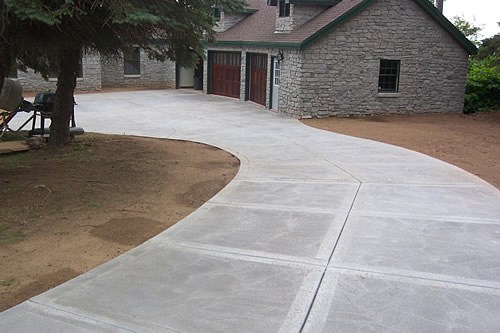
For a homeowner, a concrete driveway is a wise property investment. Durability, low-maintenance, strength, and longevity are the benefits of choosing concrete over asphalt or gravel. Though more expensive, poured concrete outlasts cobblestone, brick, or concrete paver materials. For attractiveness and long-term maintenance, concrete can be colored, stamped, and sealed. Often mistaken for cement, concrete typically consists of stone aggregate, water, and lime-based (Portland cement) composition. The size and texture of the stone aggregate largely depends upon usage of the product. Commonly used for driveway and sidewalk surfaces, finer grades of stone aggregate material vary with relation to the desired texture of the concrete slab. For smooth concrete surfaces, fine sand particles to small gravel aggregate are used. Cement contains a pulverized powder mixture of clay and limestone. Depending upon thickness and content, removal of an old reinforced concrete driveway, down to the base, takes more than eight hours with an estimated cost of up to $3,500.
After the concrete mixture is poured, leveled, and smoothed, it begins to harden. The curing period, best at 70°F, takes a few days but lasts for several months. To reinforce the concrete slab, rebar, or steel reinforcement wire, is embedded prior to the hardening and curing phases. Other strengthening and drying agents may be added to the concrete mixture. Recycled and crushed concrete may be used, as a sub-base layer, in combination with new aggregate, in new Portland cement. For the four inch cement thickness of a 20 ft. wide by 40 ft. long two-car driveway, the cost is estimated as more than $5 per square foot without added expense for increased depth, sloping, or curves. Thicker concrete is suggested for driveways containing more than two cars or heavy-duty vehicles. Concrete is best when poured at temperatures above 50°F. Pouring concrete during freezing temperatures compromises quality and strength. The driveway surface will degrade faster than if the concrete was poured and cured during warmer temperatures.
In warmer climates, relative humidity, excessive moisture, and free water, or too much water in the concrete mixture, will compromise quality and durability factors. Heat, cold, moisture, mold, salt deposits, and air circulation affect the lifespan of concrete slabs. Sealing concrete ensures protection against damage, corrosion, and staining. Do not apply a seal until the concrete has properly cured. Once applied, wait at least 72 hours before walking on the sealed surface. On an annual basis, sealing can cause excessive cracking and peeling. Seal a concrete driveway only every four to five years. Properly applied sealing products may last five to 10 years.
Either way, a concrete driveway should last a very long time. If done properly by a respected concrete company, a driveway will be something that you will not have to worry about every year. Take your time when choosing a concrete company as there are many out there that are simply interested in lining their pockets with your hard earned money.
